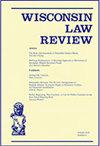Adding Value to Families: The Potential of Model Family Courts
IF 0.7
4区 社会学
Q2 LAW
引用次数: 1
Abstract
This article examines the national Model Family Court reform movement, analyzing whether the movement imitates previous attempts to improve the court through administrative and procedural reorganization, or whether the substantive foundation of the movement (whose first principles combine family unification with child safety) coupled with key structural modifications can transform the existing Family Court. The model court movement requires the judge to take a significant leadership role in restructuring court procedures and crafting and monitoring individual case resolutions. The author asks whether this new process would add value to the lives of the families involved. By examining New York court reform as well as preliminary information about the progress of model courts nationwide, a number of conclusions about the current reform effort are drawn. First, the organization of the model courts builds on a process of cooperation and collaboration that enhances the participation of both professionals and litigants. Second, the monitoring component can produce sufficient information for the court to limit its intervention into the family without increasing the risk to child safety. As a result, the overall number of cases that need court attention could be reduced and the court would be able to use its resources more effectively. The potential for transformation, however, has so far been limited by a dominant focus on administrative and procedural reform and a paucity of attention centered on preserving family integrity by utilizing the model court's unique design. Unless the model courts take the next step to fully integrate their substantive mandate into the new procedural framework, a family court paradigm that can add value to the lives of the families it serves will not be created.为家庭增加价值:示范家庭法院的潜力
本文考察了全国模范家事法院改革运动,分析该运动是否模仿了以前通过行政和程序重组来改进法院的尝试,或者该运动的实质基础(其首要原则是将家庭统一与儿童安全结合起来)加上关键的结构修改是否可以改变现有的家事法院。示范法院运动要求法官在重组法院程序和拟订和监督个别案件决议方面发挥重要的领导作用。作者想知道这个新过程是否会给相关家庭的生活增加价值。通过审查纽约法院改革以及关于全国模范法院进展的初步资料,得出了一些关于当前改革努力的结论。首先,示范法院的组织建立在一个合作与协作的过程之上,这一过程加强了专业人员和诉讼当事人的参与。其次,监测部分可以为法院提供足够的信息,以限制其对家庭的干预,而不会增加对儿童安全的风险。因此,需要法院注意的案件总数可以减少,法院将能够更有效地利用其资源。但是,改革的潜力迄今受到限制,因为主要集中在行政和程序改革上,而且很少注意利用示范法院的独特设计来维护家庭的完整。除非示范法院采取下一步措施,将其实质性任务完全纳入新的程序框架,否则就不会建立一个能够为其所服务的家庭的生活增加价值的家事法院模式。
本文章由计算机程序翻译,如有差异,请以英文原文为准。
求助全文
约1分钟内获得全文
求助全文
来源期刊

Wisconsin Law Review
Social Sciences-Law
CiteScore
1.00
自引率
16.70%
发文量
0
期刊介绍:
The Wisconsin Law Review is a student-run journal of legal analysis and commentary that is used by professors, judges, practitioners, and others researching contemporary legal topics. The Wisconsin Law Review, which is published six times each year, includes professional and student articles, with content spanning local, state, national, and international topics. In addition to publishing the print journal, the Wisconsin Law Review publishes the Wisconsin Law Review Forward and sponsors an annual symposium at which leading scholars debate a significant issue in contemporary law.
 求助内容:
求助内容: 应助结果提醒方式:
应助结果提醒方式:


